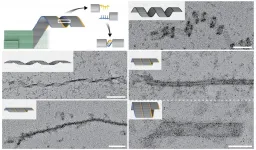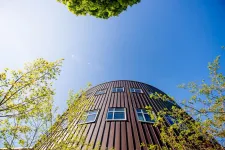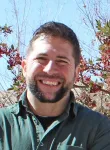Planting the seed for DNA nanoconstructs that grow to the micron scale
A concept for seeded all-or-nothing assembly of micron-scale DNA nanostructures that could extend nanofabrication capabilities and enable creation of highly specific diagnostics
2021-03-22
(Press-News.org) (BOSTON) -- A team of nanobiotechnologists at Harvard's Wyss Institute for Biologically Inspired Engineering and the Dana-Farber Cancer Institute (DFCI) led by Wyss Founding Core Faculty member William Shih, Ph.D., has devised a programmable DNA self-assembly strategy that solves the key challenge of robust nucleation control and paves the way for applications such as ultrasensitive diagnostic biomarker detection and scalable fabrication of micrometer-sized structures with nanometer-sized features. Using the method, called "crisscross polymerization", the researchers can initiate weaving of nanoribbons from elongated single strands of DNA (referred to as "slats") by a strictly seed-dependent nucleation event. The study is published in Nature Communications.
DNA nanostructures have great potential for solving various diagnostic, therapeutic, and fabrication challenges due to their high biocompatibility and programmability. To function effective diagnostic devices, for example, a DNA nanostructure might need to specifically respond to the presence of a target molecule by triggering an amplified read-out compatible with low-cost instruments accessible in point-of-care or clinical-laboratory settings.
Most DNA nanostructures are assembled using one of two main strategies that each have their strengths and limitations. "DNA origami" are formed from a long single-stranded scaffold strand that is stabilized in a two or three-dimensional configuration by numerous shorter staple strands. Their assembly is strictly dependent on the scaffold strand, leading to robust all-or-nothing folding. Although they can be formed with high purity in a broad range of conditions, their maximum size is limited. "DNA bricks" on the other hand can assemble much larger structures from a multitude of short modular strands. However, their assembly requires tightly controlled environmental conditions, can be spuriously initiated in the absence of a seed, and produces a significant proportion of incomplete structures that need to be purified away.
"The introduction of DNA origami has been the single-most impactful advance in the DNA nanotechnology field over the last two decades. The crisscross polymerization approach that we developed in this study builds off this and other foundations to extend controlled DNA self-assembly to much larger length scales," said Shih, who co-leads the Wyss' Molecular Robotics Initiative, and also is Professor at Harvard Medical School and DFCI. "We envision that crisscross polymerization will be broadly enabling for all-or-nothing formation of two- and three-dimensional microstructures with addressable nanoscale features, algorithmic self-assembly, and zero-background signal amplification in diagnostic applications that require extreme sensitivity."
Planting a seed
Having experienced the limitations of DNA origami and DNA brick nanostructures, the team started by asking if it was possible to combine the absolute seed-dependence of DNA origami assembly with the boundless size of DNA brick constructions in a third type of DNA nanostructure that grows rapidly and consistently to a large size.
"We argued that all-or-nothing assembly of micron-scale DNA structures could be achieved by designing a system that has a high free-energy barrier to spontaneous assembly. The barrier can only be bypassed with a seed that binds and arranges a set of 'nucleating' slats for joint capture of 'growth' slats. This initiates a chain reaction of growth-slat additions that results in long DNA ribbons," said co-first author Dionis Minev, Ph.D., who is a Postdoctoral Fellow on Shih's team. "This type of highly cooperative, strictly seed-dependent nucleation follows some of the same principles governing cytoskeletal actin or microtubule filament initiation and growth in cells." The elongation of cytoskeletal filaments follows strict rules where each incoming monomer binds to several monomers that have previously been incorporated into the polymeric filament and in turn is needed for binding of the next one. "Crisscross polymerization takes this strategy to the next level by enabling non-nearest neighbors to be required for recruitment of incoming monomers. The resulting extreme level of coordination is the secret sauce," said Minev.
From concept to actual structure(s)
Putting their concept into practice, the team designed and validated a system in which a tiny seed structure offers a high starting concentration of pre-formed binding sites in the form of protruding single DNA strands. These can be detected by DNA slats with six (or in an alternative crisscross system eight) available binding sites, each binding to one of six (or eight) neighboring protruding ssDNA strands in a crisscross pattern, and subsequent DNA slats are then continuously added to the elongating structure.
"Our design is remarkable because we achieved fast growth of huge DNA structures, yet with nucleation control that is orders-of-magnitude greater than other approaches. It's like having your cake and eating it too, because we readily created large-scale assemblies and did so only where and when we so desired," said co-first author Chris Wintersinger, a Ph.D. student in Shih's group who collaborated on the project with Minev. "The control we achieved with crisscross greatly exceeds that observed for existing DNA methods where nucleation can only be directed within a narrow window of conditions where growth is exceedingly slow."
Using crisscross polymerization, Shih's team generated DNA ribbons that self-assembled as a result of a single specific seeding event into structures that measured up to tens of micrometers in length, with a mass almost one hundred times larger than a typical DNA origami. Moreover, by leveraging the high programmability of slat conformations and interactions, the researchers created ribbons with distinct turns and twists, resulting in coiled and tube-like structures. In future studies, this could be leveraged to create functionalized structures that can benefit from spatially separated compartments. "An immediate application for our crisscross nanoconstruction method is as an amplification strategy in diagnostic assays following the formation of nanoseeds from specific and rare biomarkers," said co-author Anastasia Ershova, who also is a Ph.D. student mentored by Shih.
"The development of this new nanofabrication method is a striking example of how the Wyss Institute's Molecular Robotics Initiative continues to be inspired by biological systems, in this case, growing cytoskeletal filaments, and keeps expanding the possibilities in this exciting field. This advance brings the potential of DNA nanotechnology closer to solving pressing diagnostic challenges for which there currently are no solutions," said Wyss Founding Director Donald Ingber, M.D., Ph.D., who also is the Judah Folkman Professor of Vascular Biology at Harvard Medical School and Boston Children's Hospital, and Professor of Bioengineering at the Harvard John A. Paulson School of Engineering and Applied Sciences.
INFORMATION:
The study was funded by Harvard's Wyss Institute for Biologically Inspired Engineering, the National Science Foundation under award #1435964 and #CCF-1317291, the Office of Naval Research under award #N00014-15-1-0073, #N00014-18-1-2566 and #N00014-19-1-2345, a Partnership Award, a Bill & Melinda Gates Foundation (BMGF)/Ragon Global Health Innovation Partnership Award, a BMGF Joint Stanford/Ragon Sentinel Award #OPP112622, the Natural Sciences and Engineering Research Council of Canada under award #PGSD3-502356-2017, and an Alexander S. Onassis Scholarship for Hellenes.
PRESS CONTACTS
Wyss Institute for Biologically Inspired Engineering at Harvard University
Benjamin Boettner, benjamin.boettner@wyss.harvard.edu, +1 617-432-8232
The Wyss Institute for Biologically Inspired Engineering at Harvard University (http://wyss.harvard.edu) uses Nature's design principles to develop bioinspired materials and devices that will transform medicine and create a more sustainable world. Wyss researchers are developing innovative new engineering solutions for healthcare, energy, architecture, robotics, and manufacturing that are translated into commercial products and therapies through collaborations with clinical investigators, corporate alliances, and formation of new startups. The Wyss Institute creates transformative technological breakthroughs by engaging in high risk research, and crosses disciplinary and institutional barriers, working as an alliance that includes Harvard's Schools of Medicine, Engineering, Arts & Sciences and Design, and in partnership with Beth Israel Deaconess Medical Center, Brigham and Women's Hospital, Boston Children's Hospital, Dana-Farber Cancer Institute, Massachusetts General Hospital, the University of Massachusetts Medical School, Spaulding Rehabilitation Hospital, Boston University, Tufts University, Charité - Universitätsmedizin Berlin, University of Zurich and Massachusetts Institute of Technology.
[Attachments] See images for this press release:

ELSE PRESS RELEASES FROM THIS DATE:
2021-03-22
One of the surest signs of spring is the vibrantly lime-green tinge trees develop as their buds open and tiny new leaves unfurl. Bud-break is the scientific name for this process -- a straightforward term for the grand genetic mechanism that allows trees to leaf out and do their summer work of photosynthesis to store up energy for the coming winter.
Bud-break is precluded by bud-set, which occurs in the autumn. After trees have dropped their leaves and as the days shorten and grow colder, new buds grow on branches. Like many wildflowers, trees require a period of dormancy at colder temperatures -- a process fine-tuned by evolution ...
2021-03-22
DURHAM, N.C. -An unfortunate biological "feed-forward" loop drives cartilage cells in an arthritic joint to actually contribute to progression of the disease, say researchers at Duke University and Washington University in Saint Louis.
Pain researcher and mechanobiologist Wolfgang Liedtke, a professor of neurology at Duke, partnered with former Duke colleague and cartilage expert Farshid Guilak, now at the Washington University School of Medicine, to examine the activity of pressure-sensitive ion channels in cartilage. Their study appears the week of March 22 in the Proceedings of the National Academy of Sciences.
Cartilage is the highly lubricated, low-friction, elastic tissue that lines ...
2021-03-22
There are 12 essential attributes that explain why commercial carbon capture and sequestration projects succeed or fail in the U.S., University of California San Diego researchers say in a recent study published in Environmental Research Letters.
Carbon capture and sequestration (CCS) has become increasingly important in addressing climate change. The Intergovernmental Panel on Climate Change (IPCC) relies greatly on the technology to reach zero carbon at low cost. Additionally, it is among the few low-carbon technologies in President Joseph R. Biden's proposed $400 billion clean energy plan that earns bipartisan support.
In the last two decades, private industry and government have ...
2021-03-22
Amsterdam, NL, March 22, 2021 - The COVID-19 pandemic has had a profound impact on our world, with disequilibrium, uncertainty, and human suffering making it difficult to envision a human, societal and individual future. Milan Zeleny, PhD, Professor Emeritus of Management Systems, Fordham University, New York, NY, USA, and world-recognized authority on decision making, productivity, knowledge management, and more recently the corporation as a living organism, says that "COVID-19 is rapidly changing from a cause to one of the symptoms of an increasingly unhinged world."
Writing in the journal Human Systems Management, published ...
2021-03-22
A University of New Mexico research team conducted a data analysis that has found that as a larger portion of the population gets vaccinated against COVID-19, it becomes economically advantageous to start relaxing social distancing measures and open businesses.
Francesco Sorrentino, associate professor of mechanical engineering, is lead author of "Data-driven Optimized Control of the COVID-19 Epidemics," published March 22 in Scientific Reports.
Co-authors of the study are Afroza Shirin of the Department of Mechanical Engineering and the Department of Electrical and Computer Engineering, and Yen Ting Lin, a staff scientist of the Information Science Group in the Computer, Computational ...
2021-03-22
Despite the fact that viruses are among the simplest biological entities--consisting only of DNA or RNA encapsulated in a protein shell--they can have devastating consequences, with viruses such as influenza, human immunodeficiency virus (HIV), and Ebola having dramatically affected the course of human history. Because they generally lack the cellular machinery necessary to reproduce, they propagate by hijacking host cells, often to the host's detriment. While their status as a "living" organism may be in question, there is no doubt that viruses are shaped by evolutionary forces that influence their genomes, as well as their replication, host range, virulence, and other features. With the emergence of ...
2021-03-22
The same process that drains the battery of your cell phone even when it's turned off is even more of a problem for lithium-metal batteries, which are being developed for the next generation of smaller, lighter electronic devices, far-ranging electric vehicles and other uses.
Now scientists at Stanford University and the Department of Energy's SLAC National Accelerator Laboratory have taken the first atomic-scale look at how this process, called "calendar aging," attacks lithium-metal anodes, or negative electrodes. They discovered that the nature of the battery electrolyte, which carries charge between the electrodes, has a big impact on aging - a factor that needs to be taken into account ...
2021-03-22
The first documented record of salt as an ancient Maya commodity at a marketplace is depicted in a mural painted more than 2,500 years ago at Calakmul, a UNESCO World Heritage site in the Yucatan Peninsula in Mexico. In the mural that portrays daily life, a salt vendor shows what appears to be a salt cake wrapped in leaves to another person, who holds a large spoon over a basket, presumably of loose, granular salt. This is the earliest known record of salt being sold at a marketplace in the Maya region. Salt is a basic biological necessity and is also useful for preserving food. Salt also was valued ...
2021-03-22
Two new environmental policy briefings, aimed at decision makers working on rapidly expanding urban areas in southern Africa, emphasise that local community voices must be included in the early planning stages to minimise ecological impacts.
Urban populations across the African continent and in particular the surrounding areas of urban sprawl, are forecasted to triple by 2050, resulting in higher rates of land conversion that have implications for managing significant environmental changes that lie ahead.
This expansion is happening faster than infrastructure changes can keep-pace, meaning that residents do not have access to important services to reduce the impact of climate-related events such as flooding, droughts, and heat-stress.
A new policy briefing, led by ...
2021-03-22
RIVERSIDE, Calif. -- A University of California, Riverside, study analyzing fourth-generation electronic cigarette, or EC, pod atomizer design features has found the pod atomizers are similar to those of previous generations and contain elements that may adversely affect health and accumulate in the environment.
EC atomizers are chambers that hold nicotine-containing fluid and upon heating generate an aerosol. The pod-style e-cigarettes have become very popular, especially with young people.
The elements/metals in atomizers are important because chronic exposure could adversely affect human health. Further, EC pod products, which eventually enter the environment, could ...
LAST 30 PRESS RELEASES:
[Press-News.org] Planting the seed for DNA nanoconstructs that grow to the micron scale
A concept for seeded all-or-nothing assembly of micron-scale DNA nanostructures that could extend nanofabrication capabilities and enable creation of highly specific diagnostics





